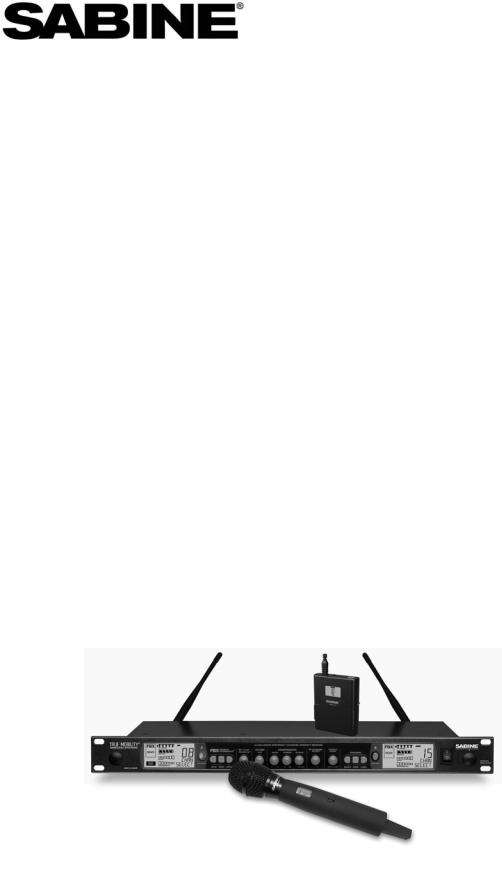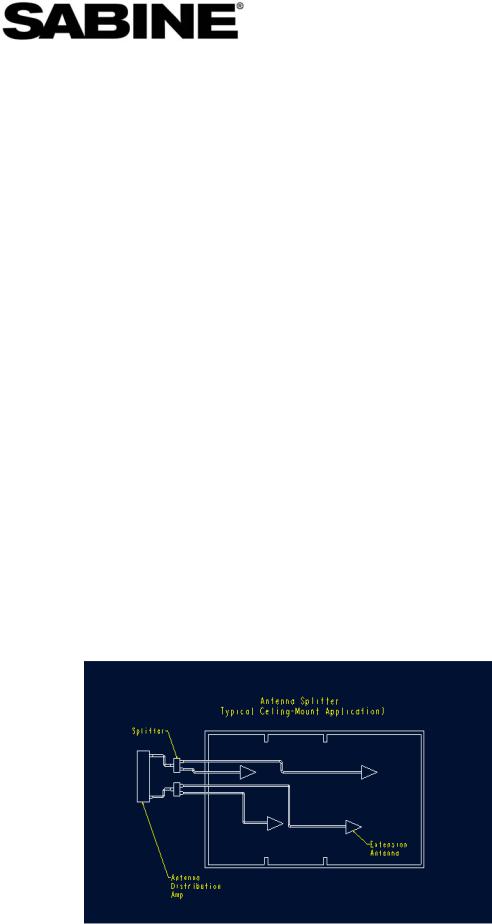Sabine SWM7000 User Manual

SWM7000 2.4 GHz Wireless Microphone Systems
Application and Troubleshooting Guide
Table of Contents
1. DROPOUTS |
2 |
2. RF INTERFERENCE |
5 |
3. SOUND QUALITY |
7 |
4. BATTERY CHARGING SYSTEM |
8 |
5. RECEIVERS |
8 |
6. TRANSMITTERS |
9 |
7. SABINE REMOTE SOFTWARE |
9 |
8. UPGRADING RECEIVER FIRMWARE AND REMOTE CONTROL SOFTWARE |
11 |
9. DIP SWITCHES |
12 |
10. CUSTOMER SERVICE |
12 |
Sabine Wireless: Application and Troubleshooting Guide |
080404 |
1 of 12 |

1.Dropouts
1.1.What causes dropouts? Wireless microphone systems are vulnerable to dropouts, (momentary loss of audio) and it is often difficult to pinpoint the exact cause of the problem. Dropouts can be caused by improper antenna positioning, defective antenna cabling, a problem with the transmitter, a problem with the receiver, a problem with the sound system. Interference with other RF sources almost never causes dropouts but it can cause sputtering and ticking in the audio. If you are experiencing dropouts, consider interference as a last resort. We recommend the following steps to quickly zero in on the problem.
1.2.Upgrade your receiver firmware. The first step is always to be certain that you have installed the latest versions of the SWM7000 receiver firmware and Remote software. See the Sabine Remote Software section below.
1.3.Is the problem with the sound system? Plug a wired mic into the audio cable plugged into the back of the receiver. If there are still dropouts, you know the problem is downstream of your wireless mic. If dropouts stop, you know the problem is with your wireless mic.
1.4.Problem with the antennas. Improper antenna positioning is probably the most common cause of dropouts. The output power of wireless microphones is limited by governmental agencies to reduce the chances that transmitters in a neighborhood will interfere with each other. The downside is that your antennas must be carefully placed in order to pick up relatively weak signals.
1.4.1.True Diversity The SWM7000 system comes with two dipole antennas (sometimes called “rubber duckies” or “rabbit ears”) that mount on the back of the receiver. Two SWA700 Front-To-Rear cables are also included so that you can mount the dipole antennas on the receiver’s rack ears.
Dipole antennas have a polar pattern of sensitivity that forms a donut shape (toroid) with the antenna sticking through the donut hole. The receiver’s reception is weakest along the axis of its antenna. The transmitter’s antenna also has a donut-shaped polar pattern with the transmitter sticking through the hole. The transmitter’s signal strength is weakest if you point the end of mic antenna directly at the receiver’s antenna.
If there was only one receiver antenna and you held the transmitter in a particular orientation, the signal strength would drop dramatically possibly causing dropouts. Another common problem occurs when a signal that propagates directly from the transmitter to the receiver is mixed with the same signal after it reflects off an object back to the antenna. Both signals are identical except the reflected signal is slightly out of phase. Mixing these signals can cause a dramatic drop in signal strength. This problem is common to all wireless microphone systems.
1.4.2.The SWM7000 receiver overcomes this problem by using a true diversity system that features two independent receiver circuits per RF channel. The receiver constantly monitors the signal strength from both antennas and automatically switches to the antenna with the strongest signal.
Sabine Wireless: Application and Troubleshooting Guide |
2 of 12 |

1.4.3.Antenna placement It is imperative that you orient the receiver antennas so that if one has a weak signal, the other will likely have a strong signal. Here is one way to do it. Orient the left antenna so that it points to 10:00 and the right antenna so that it points to 2:00. Placing the dipole antennas parallel to each other (for example, both sticking straight up) defeats diversity and causes dropouts.
1.4.4.Line of Sight RF signals will not go through metal objects and thick walls. Do not let the antennas be shielded by the equipment rack or the receiver’s case. Both receiver antennas should be completely visible (in the line of sight) to the performer. There should be no obstructions. Use the SWA7000 front to rear extension cables (shipped with the receiver) if you wish to mount the antennas on the front of the receiver. Placing one or both antennas out of the line of sight of the transmitter defeats diversity and causes dropouts.
1.4.5.Range The SWM7000 with dipole antennas has a 300 foot range line-of-sight (no objects between the transmitter and receiver antenna, including hands and bodies). The range may be shorter if you stand between the transmitter and the receiver.
1.4.6.Grabbing the antenna of any hand-held or belt-pack transmitter dramatically reduces the radiated power and increase the chance of a dropout. Keep hands off of the antennas.
1.4.7.Antenna Distribution Amp Receiver antennas in a rack can interfere with each other. Don’t let them touch each other. If you have more than three adjacent receivers in the rack, it is recommended that you consolidate the antennas by using Sabine’s SWA6SS Antenna Distribution Amp (ADA). The ADA will allow you connect up to six 2-channel receivers to a single pair of antennas. You can daisychain several SWA6SS ADAs together to connect up to 70 receiver channels to one pair of antennas. If you do not have an ADA, separate the receivers in the rack. Terminator caps are included in the distribution amp for unused connectors. You will probably have dropouts if you do not have terminator caps, especially if the plastic sleeves on the antenna connectors are black. Terminators are not as critical if the plastic sleeve on the insulation antenna connectors is white, but they are still recommended. (Antennas cannot be substituted for caps).
1.4.8.Extension Antennas We recommend using the SWASS-EXT-2 extension antennas to maximize reception and minimize the potential for dropouts, especially if the receivers are out of the line of sight, if you are using multiple receivers, or if the range is more than 100 feet or so. SWASS-EXT-2 increases gain either +22 or +44 dB. The +44 dB high gain setting should only be used for long cable runs – cable runs greater than 80 feet. Use the Low Gain setting for shorter runs. Using the high gain setting on short runs can over-modulate the RF and cause dropouts. See the operating guide for the SWASS-EXT-2 for more details. Remove the plastic cover to see the High/Low gain switch, and to see the LED that indicates the presence of phantom power from either a Sabine receiver or antenna distribution amplifier.
1.4.9.Placing Extension Antennas Extension antennas are sold in pairs. You can use either one for the left or right antenna. In order for the system to be effective, both
Sabine Wireless: Application and Troubleshooting Guide |
3 of 12 |

extension antennas should be in a good pickup position at all times but separated by about ten or fifteen feet if the antennas are within 100 or so feet.
If you put the antennas too far apart, i.e., at opposite ends of the room, or in separate rooms, to improve coverage, diversity is defeated and you will get dropouts. In other words, diversity is more important than coverage.
1.4.10.If you mount the extension antennas in the ceiling, the antennas metallic backplane must be orientated parallel to the floor and the antennas must not be blocked by pillars, lights or similar obstructions. Aim the hole in the plastic cover toward the performance area.
1.4.11.Extension Antenna Cables Use 50 Ohm coax cable to connect the extension antennas to the receiver or to the distribution amp. If the cable is about 50 feet or less, use Belden RG58 or equivalent cable. These cables use a TNC connector, and are compatible with Sabine’s receivers and antennas. Sabine offers this cable in 15 or 30 foot lengths (SWACA15-TNC or SWACA30-TNC). Use Belden RG8, or equivalent, for longer cable runs to reduce signal loss. These cables require an N- connector. Use the Sabine SWATNC-N adaptor cable to connect the RG8 cables to the extension antenna. Check your connections carefully – poorly installed connectors are a major cause of dropouts!
1.4.12.The left and right antenna cables should be the same length. Different lengths could defeat diversity and cause dropouts.
1.4.13.The extension antennas pick up pattern is limited to the front side with the plastic cover. There is very little sensitivity on the metallic backside.
1.4.14.Antenna Splitter A number of articles have been published warning against stringing antennas in series in an attempt to extend the operating range of a wireless microphone system. They warn about dropouts resulting from comb-filter interference. What these articles forget is that microphone systems have diversity. The chance of both sets of antennas will experience a filter at the same location and time is extremely low, especially if the antennas are offset as per the following diagram:
Sabine Wireless: Application and Troubleshooting Guide |
4 of 12 |
